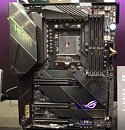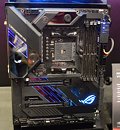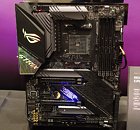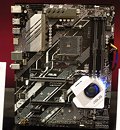Tuesday, June 11th 2019

Alleged ASUS AMD X570 Motherboard Price-list Paints a Horror Story
A reliable source based in Taiwan shared with us the price-list of upcoming AMD Ryzen 3000 X570 chipset motherboards by leading manufacturer ASUS. These MSRP prices in U.S. Dollars paint a grim picture of these boards being significantly pricier than previous-generation motherboards based on the AMD X470 chipset. We already got hints of AMD X570 motherboards being pricey when MSI CEO Charles Chiang, who is known for not mincing his words in public, made it clear that the industry is no longer seeing AMD as a value-alternative second-fiddle brand to Intel, and that AMD will use its performance leadership to command premium pricing for these motherboards, even though across generations, pricing of AMD processors are going to remain flat. The Ryzen 7 3700X, for example, is launching at exactly the same $329 launch price as the Ryzen 7 2700X.
Even MSI CEO Chiang's statement couldn't prepare us for the prices we're seeing for the ASUS motherboard lineup. The cheapest AMD X570 motherboard from ASUS is the Prime X570-P, which is priced at USD $159.99. Its slightly bolstered twin, the TUF Gaming X570-Plus will go for $169.99. A variant of this exact board with integrated Wi-Fi 6 will be priced at $184.99. This is where things get crazy. The Prime X570-Pro, which is the spiritual-successor of the $150 Prime X470-Pro, will command a whopping $249.99 price-tag, or a $100 (66 percent) increase! The cheapest ROG (Republic of Gamers) product, the ROG Strix X570-F Gaming, will ship with an HEDT-like $299.99 price. This is where the supposed "high-end" segment begins.The ROG Strix X570-E Gaming is a slightly spruced-up Strix-F, with a handful more connectivity options, and an extra M.2 slot. This board will be priced at $329.99. And we're still with the "tier-two" ROG Strix family. The ROG Crosshair VIII Hero is what you'd want for the premium ROG experience, and a premium CPU VRM solution. This board is priced at $359.99, over $100 more than the Crosshair VII Hero. Need Wi-Fi? Pull out another Jackson for the $379.99 ROG Crosshair VIII Hero Wi-Fi, which comes with 802.11ax WLAN.
Record-seeking OC wizards who want to push the Ryzen 9-series processors, such as the $749 Ryzen 9 3950X to their limits, will have to spend almost the same amount of money on the motherboard, with the ROG Crosshair VIII Formula, which at $699.99, is pricier than even certain ROG Rampage Extreme products from Intel's HEDT platform. In all, AMD, like any for-profit company on the planet, wants to monetize its performance-leadership over Intel to the fullest.
The reasons for these price increases could be many, besides AMD simply wanting to turn its performance leadership into cash. For one, the AMD X570 chipset is a big and hot (~15W TDP) piece of silicon AMD designed in-house, with a large PCI-Express gen 4.0 switching fabric, and more downstream connectivity than the ASMedia-sourced X470 "Promontory." This chipset needs a much more capable cooling solution than what the X470 needed, including in many cases, an active fan-heatsink. AMD has also dialed up the electrical and physical requirements, with a stronger CPU VRM specification, possibly more than four PCB layers for improved memory wiring, and external PCI-Express gen 4.0 re-driver and lane segmentation components that could be expensive on account of being new.
To most PC buyers, though, there are alternatives within AMD. As we mentioned earlier, processor pricing over generations hasn't increased. The 3700X is priced on par with the launch price of the 2700X it succeeds, and the Ryzen 5 3600 is being launched at the same $199 as the Ryzen 5 2600. You can very much do pair these processors with motherboards based on the older AMD X470 and B450 chipset motherboards, which are stocked up plenty in the market, are priced reasonably, and a majority of models support the USB BIOS Flashback feature, letting you update their UEFI firmware to the latest versions that add 3rd generation Ryzen support, without needing to borrow an older Ryzen chip from a friend. You lose out on PCI-Express gen 4.0 and additional M.2 slots, but that's a compromise you'll have to make. Consider the low-power 400-series chipsets not needing fan-heatsinks to be a sweetener.
Even MSI CEO Chiang's statement couldn't prepare us for the prices we're seeing for the ASUS motherboard lineup. The cheapest AMD X570 motherboard from ASUS is the Prime X570-P, which is priced at USD $159.99. Its slightly bolstered twin, the TUF Gaming X570-Plus will go for $169.99. A variant of this exact board with integrated Wi-Fi 6 will be priced at $184.99. This is where things get crazy. The Prime X570-Pro, which is the spiritual-successor of the $150 Prime X470-Pro, will command a whopping $249.99 price-tag, or a $100 (66 percent) increase! The cheapest ROG (Republic of Gamers) product, the ROG Strix X570-F Gaming, will ship with an HEDT-like $299.99 price. This is where the supposed "high-end" segment begins.The ROG Strix X570-E Gaming is a slightly spruced-up Strix-F, with a handful more connectivity options, and an extra M.2 slot. This board will be priced at $329.99. And we're still with the "tier-two" ROG Strix family. The ROG Crosshair VIII Hero is what you'd want for the premium ROG experience, and a premium CPU VRM solution. This board is priced at $359.99, over $100 more than the Crosshair VII Hero. Need Wi-Fi? Pull out another Jackson for the $379.99 ROG Crosshair VIII Hero Wi-Fi, which comes with 802.11ax WLAN.
Record-seeking OC wizards who want to push the Ryzen 9-series processors, such as the $749 Ryzen 9 3950X to their limits, will have to spend almost the same amount of money on the motherboard, with the ROG Crosshair VIII Formula, which at $699.99, is pricier than even certain ROG Rampage Extreme products from Intel's HEDT platform. In all, AMD, like any for-profit company on the planet, wants to monetize its performance-leadership over Intel to the fullest.
The reasons for these price increases could be many, besides AMD simply wanting to turn its performance leadership into cash. For one, the AMD X570 chipset is a big and hot (~15W TDP) piece of silicon AMD designed in-house, with a large PCI-Express gen 4.0 switching fabric, and more downstream connectivity than the ASMedia-sourced X470 "Promontory." This chipset needs a much more capable cooling solution than what the X470 needed, including in many cases, an active fan-heatsink. AMD has also dialed up the electrical and physical requirements, with a stronger CPU VRM specification, possibly more than four PCB layers for improved memory wiring, and external PCI-Express gen 4.0 re-driver and lane segmentation components that could be expensive on account of being new.
To most PC buyers, though, there are alternatives within AMD. As we mentioned earlier, processor pricing over generations hasn't increased. The 3700X is priced on par with the launch price of the 2700X it succeeds, and the Ryzen 5 3600 is being launched at the same $199 as the Ryzen 5 2600. You can very much do pair these processors with motherboards based on the older AMD X470 and B450 chipset motherboards, which are stocked up plenty in the market, are priced reasonably, and a majority of models support the USB BIOS Flashback feature, letting you update their UEFI firmware to the latest versions that add 3rd generation Ryzen support, without needing to borrow an older Ryzen chip from a friend. You lose out on PCI-Express gen 4.0 and additional M.2 slots, but that's a compromise you'll have to make. Consider the low-power 400-series chipsets not needing fan-heatsinks to be a sweetener.




97 Comments on Alleged ASUS AMD X570 Motherboard Price-list Paints a Horror Story
At these speeds signal integrity becomes challenging. You often need to go for better PCB material with lower Er values which will make PCB more expensive.
I myself being hardware project manager and designer in the area of high frequency and high speed have to deal with such topics. At certain signal speeds PCB becomes one of the expensive parts of the BOM.
In one of the projects I worked on containing multiple 10Gbit/s high speed links with FPGA, DDR3, high speed DAC and ADC and RF signal at 2.7GHz frequency, we needed 16 layer board with 2.5 Er which costed alone around 60 Euros per PCB.
For how I'm looking at things are the Taichi at £190 ish, is like the Hero and then the Taichi Ultimate at £230 is like the Hero Wi-Fi... I do think that the Ultimate board does seem to give a few more features such as 10Gb as an example.. Both Taichi boards do come with Wi-Fi as standard from the bit of text above...
Meh, what do I know :D :laugh:
PCIe 4.0 needs at least a 6-layer board for signaling.
6-layer (minimum) boards cost a lot more.
Do the math.1.) No they aren't
2.) Wrong thread maybe?
Eight layers, I wouldn't doubt, 10, hmmm, not so likely unless you have some super high-end workstation or server boards.
Neither am I, just pointing out that Asus is not the most expensive when it comes the X570 boards, since they seemingly got a lot of flack here.
It's not that simple, as the X570 chipset itself is comparable to Intel's Z390 in terms of cost (I'm afraid I don't have exact numbers, but same ballpark), but the addition of the PCIe 4.0 redrivers/retimers adds about $10-20 in cost to each board. On top of this, a lot of new, but maybe not very obvious board design changes have had to be developed for PCIe 4.0, which costs R&D time and money and the boards makers seemingly wants to recuperate that money as quickly as possible. This all leads to higher priced retail products, especially when the board makers knows that AMD has a good CPU coming, so they try to see what the market will bear. This happens time and time again, so nothing new there.ASRock hasn't had anything to do with Asus for around a decade, so please update your memory banks...
ASRock is owned by Pegatron which was entirely separated from Asus in 2012 and ASRock has been independent since the split between Asus, Pegatron and Unihan in 2008.
Please see the link in my earlier comment.
Layers are usually not added for the hell of it, as it makes for quite and expensive PCBA really quick.
16 layers must've been some seriously special gear.
It is hard to believe that they use 4 or 6 layer board.
4 layer would mean only 2 layers for routing. How do they rout all signals out of processor with only 2 layers available?
Furthermore, you need refernce ground layer and also you have to put power plane layers.
4 layers would mean most of signals on top/bottom layer with reference in 2 and 3 layers.
Power planes also sharing ground layer in 2 and 3 or?
DDR routing is also usually very critical. These are usually impedence controlled lines needing proper reference planes which means in that area where they are routed the refernce plane in not allowed to be broken with other signals passing through. This would be a challange in board with 4 laers only.
6 layers could work with having dedicated layer for power planes but challenging for routing all signal out of processor. Maybe could work by using micro-vias which are also expensive.
I would say 8 layer would be more proper. 10 layer maybe needed to rout out all the signals out of so many processor pins.
I understand the only valid point of small fans being noisy, if they're not noisy then it's no issue, WE DON'T KNOW IF THEY'RE GOING TO BE NOISY YET, don't jump to conclusions. If they are noisy, petition the Mobo factory to FIX THE NOISE BY MAKING A BIGGER OR BETTER FAN BUT KEEP THE PERFORMANCE !!! But I know you whiners, if they added a GIANT fan on there you'd be complaining it's "OH MAY GAWD A BIG FAN ON THE CHIPSET" You just find ANYTHING to whine about that pertains nothing other than petty CONVENIENCE. Put the PC in a refrigerator then, that'll not only cool it but, but also keep the noise out, where's the PC-master-race-improvisation-tech-geek spirit, come on, FIGURE IT OUT.
It's like little kids from a kindergarden, as soon as something's a bit out the ordinary they have this stupid dumb OH MAY GAWD reaction. OH MY GAWD I NEVER SAW A LITTLE FAN BLOWING A LITTLE CHIP BEFORE.
OH MY GAWD IN ORDER TO GET TO THE MOON IN 10 MINUTES I HAVE TO COOL THE ION ENGINES WITH 300 COOLERS WAAAAAA .. because it's reality, it's not fairy tale land. Consoles come covered up in a box so it's not visible to the most users what goes inside, PC hardware comes relatively barebone, get on with the methods/culture of PC or GTFO I'd say :)
And the way the small cooler is hidden behind the chipset cooling apparatus/heatsink, I hardly even noticed it from the pictures if I didn't read about it it's there. There's SO many things they can do to make that presence of the fan and it's noise to be a moot point, that's the kind of stuff I'd rather see the community to cheer about, you don't have to remove the damn fan, all you need is a bit of inginuety to solve the problems in another way.
/rant
But will they, especially the B450, handle the much in terms of RAM speed? RAM speed may become one of the crucial dividing lines, especially since B die has been EOLed.
Buildzoid also said that only MSI B450 boards, like the Tomahawk and Pro Carbon, have decent-quality MOSFETs, as I recall. I have read a report recently that MSI pulled a switcheroo on one of its boards (Intel perhaps), substituting junk MOSFETs in a 2.0 revision of "the same board". This sort of thing is, unfortunately, too common in our Wild West unregulated motherboard market. Companies get to pull switcheroos and flat-out lie about phase count. They have been caught so many times and simply say it's a mistake and apologize. I think Gigabyte is the latest company to blame its marketing department, or whatever, as if marketing employees ignore the information they're sent by the engineers and managers. Nvidia made the same bogus claim about the 970 during VRAMGate. The 2.0 version of the UD3P AM3+ board from Gigabyte was highly-touted in forums and marketing for having an 8 phase VRM. In reality, it was a 4 phase with a doubler and the 2.0 revision stripped components so the board wouldn't post past the 4.4 GHz multiplier. Gigabyte ignored the problem and never updated the BIOS to even prevent people from using higher than that multiplier. The big trick in recent times, though, has been to double up on chokes and other irrelevancies in order to mask the outright lie about phase count. At least a doubled 4 phase is somewhat an 8 phase. That kind of trickery wasn't good enough, apparently. Not even putting in a doubler became the next innovation.
"It's a mistake that we were caught. It will be a mistake the next time you catch us."Because they're a suboptimal kludge.
1) Prone to failure.
2) Noisy.
3) Dust.That's what Anandtech's writer said. However, in the same article it was mentioned that Gigabyte will be selling 4 layer 570s.
Inb4, motherboard makers report record lows sales despite record high profits.
Apparently EVGA is going for 10 on their high-end boards, something I'd missed.
Even something fairly high-end like this, is only six layers www.aorus.com/Z390-AORUS-ULTRA-rev-10
Think progress, you seam stuck on intels upgrade path , same shit year after year +10% and a new motherboard with only high speed usb4 alpha ports as an innovation.
When intel bring pciex 4 their board price WILL increase too.
It would be interesting to have a look at Gerber data of modern mainboards to see how they do the fan-out of all impedance controlled differential and single ended lines out of processor with 6 layers. :p
Maybe my layout colleagues can learn somethings. :laugh:
In any case, I find Crosshair VIII Hero WIFI interesting but I am not too much in hurry to switch the platform.
I own 2700x with Crosshair VII Hero WIFI and Radeon VII watercooled.
I find 3800x as intersting processor but would like to see reviews how much it is faster than 2700x and if it makes any sense to switch.
This new setup is gonna be expensive enough,so im defo going for no fan option.
I hope to put a 3900x in it and be done.
Look at the market, Nvidia have upsold twice in the last few years, Intel prices have increased on mainstream and because they could they made hedt platform with higher pricing.
And intel were selling us quads for years man, with socket swaps that WERE NOT needed,, theses boards run up to 16 cores, I'm telling you as an engineer , pciex 4 takes more R and D, testing and more expensive parts including more parts (redriver chip/s).
With boards from 160-700 quid i don't see your point as valid.
As I said, watch intels prices , have you seen some of the boards you can buy Now for Intel chips.
Because you don't see it? , just means you don't see it.
There's a Bit of gouging going on but it's not Amd that Makes the boards.
Granted not that much, just saying it's a factor.